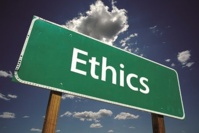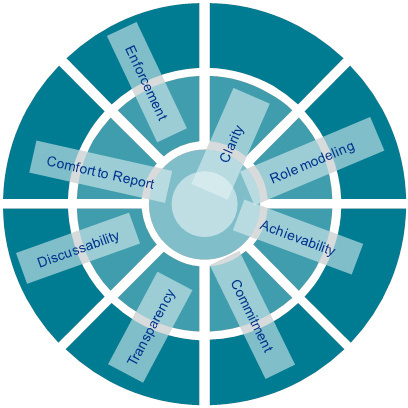
“We conclude there was a systemic breakdown in accountability and ethics. We witnessed an erosion of standards of responsibility and ethics that exacerbated the financial crisis.” This was one of the conclusions of the United States Financial Crisis Inquiry Commission. Similar observations have been made by many other people that feel something is wrong with the ethical culture in some organizations in the financial in particular. How does the ethical culture in your organization look like?
While most members of an organization have an implicit understanding of the (ethical) culture of their organization, it is much more difficult to make this understanding explicit and measurable. As everyone perceives the elements of an ethical culture in his or her own way, simple generalization from one person’s understanding to others in the organization is not possible. To systematically assess the organization’s ethical culture, it is useful to break it down into specific dimensions. Eight main dimensions of ethical culture can be distinguished, and each dimension can be addressed by some key questions.
The eight dimensions of ethical culture
While most members of an organization have an implicit understanding of the (ethical) culture of their organization, it is much more difficult to make this understanding explicit and measurable. As everyone perceives the elements of an ethical culture in his or her own way, simple generalization from one person’s understanding to others in the organization is not possible. To systematically assess the organization’s ethical culture, it is useful to break it down into specific dimensions. Eight main dimensions of ethical culture can be distinguished, and each dimension can be addressed by some key questions.
The eight dimensions of ethical culture

1. Clarity of ethical standards
How clear are the expectations regarding their conduct for the employees and managers? Are these expectations communicated understandably? Are they sufficiently specific for employees to apply them in their daily activities?
2. Ethical role modeling by leaders and supervisors
Do the organization’s leaders behave according to the normative expectations? Is this behavior visible? Are leaders perceived to “walk the talk”?
3. Achievability of ethical norms
Does the organization create conditions which enable employees to comply with the normative expectations? Do the members have sufficient time, budgets, equipment, information and authority to carry out their tasks in line with the normative expectations? Are the (performance) goals by the organization set that they can be reached with appropriate means?
4. Commitment to the ethical norms
Does the organization create an environment in which its members feel committed to the espoused values and norms? Do the members feel respected and treated fairly by the organization, such that they are in turn willing to support and uphold the organization’s norms?
5. Transparency of (un)ethical behavior
Is (un)ethical behavior of others visible? Are the consequences of their own actions visible to the members of the organization? Is the behavior of the members, and its consequences, visible to colleagues, subordinates, and supervisors?
6. Discussability of ethical matters
Is criticism and questioning accepted in the organization? Can members of the organization obtain advice on dilemmas and issues in relation to the behavior that is expected from them? Is it taboo to mix ethical issues with “pure business decisions”?
7. Comfort to report possible misconduct
Is there a possibility for employees to report unethical behavior? Does the organization emphasize that reporting of unethical behavior is expected and desirable? Does the organization communicate that anyone making such reports in good faith will be protected from retaliation?
8. Enforcement of ethical norms
Are the organization’s members held accountable for their behavior? Is behavior in violation of the normative expectations consistently sanctioned if detected? Do members perceive the organization as a “just place” where everyone’s actions are judged, sanctioned, and rewarded appropriately according to the espoused norms and values?
The questions listed above for each of the eight dimensions all revolve around impressions, perceptions, and interpretations of the employees. They base their behavior on their own understanding and judgments. This implies that an organization’s ethical culture should be assessed by explicitly asking employees for those perceptions and interpretations. Employees are likely to feel more comfortable to honestly and openly answer questions about their views on the ethical culture if an independent external party, rather than their managers, asks them.
Thus, even though the concept of ethical culture is rather difficult to grasp and measure for an organization, there are methods and tools available which enable organizations to systematically look into their ethical culture. This assessment of the existing ethical culture is the first step towards changing the ethical culture.
More information on assessing the ethical culture:
http://www.kpmg.com/CH/de/services/Advisory/risk-consulting/Forensic/Seiten/Default.aspx
References
Kaptein, S.P. (2008). Developing and testing a measure for the ethical culture of organizations: the corporate ethical virtues model. Journal of Organizational Behavior, 29(7), 923-947.
Financial Crisis Inquiry Commission (2011-01-25), The Financial Crisis Inquiry Report: Final Report of the National Commission on the Causes of the Financial and Economic Crisis in the United States, Washington, D. C.: Government Printing Office, http://www.gpo.gov/fdsys/pkg/GPO-FCIC/content-detail.html
How clear are the expectations regarding their conduct for the employees and managers? Are these expectations communicated understandably? Are they sufficiently specific for employees to apply them in their daily activities?
2. Ethical role modeling by leaders and supervisors
Do the organization’s leaders behave according to the normative expectations? Is this behavior visible? Are leaders perceived to “walk the talk”?
3. Achievability of ethical norms
Does the organization create conditions which enable employees to comply with the normative expectations? Do the members have sufficient time, budgets, equipment, information and authority to carry out their tasks in line with the normative expectations? Are the (performance) goals by the organization set that they can be reached with appropriate means?
4. Commitment to the ethical norms
Does the organization create an environment in which its members feel committed to the espoused values and norms? Do the members feel respected and treated fairly by the organization, such that they are in turn willing to support and uphold the organization’s norms?
5. Transparency of (un)ethical behavior
Is (un)ethical behavior of others visible? Are the consequences of their own actions visible to the members of the organization? Is the behavior of the members, and its consequences, visible to colleagues, subordinates, and supervisors?
6. Discussability of ethical matters
Is criticism and questioning accepted in the organization? Can members of the organization obtain advice on dilemmas and issues in relation to the behavior that is expected from them? Is it taboo to mix ethical issues with “pure business decisions”?
7. Comfort to report possible misconduct
Is there a possibility for employees to report unethical behavior? Does the organization emphasize that reporting of unethical behavior is expected and desirable? Does the organization communicate that anyone making such reports in good faith will be protected from retaliation?
8. Enforcement of ethical norms
Are the organization’s members held accountable for their behavior? Is behavior in violation of the normative expectations consistently sanctioned if detected? Do members perceive the organization as a “just place” where everyone’s actions are judged, sanctioned, and rewarded appropriately according to the espoused norms and values?
The questions listed above for each of the eight dimensions all revolve around impressions, perceptions, and interpretations of the employees. They base their behavior on their own understanding and judgments. This implies that an organization’s ethical culture should be assessed by explicitly asking employees for those perceptions and interpretations. Employees are likely to feel more comfortable to honestly and openly answer questions about their views on the ethical culture if an independent external party, rather than their managers, asks them.
Thus, even though the concept of ethical culture is rather difficult to grasp and measure for an organization, there are methods and tools available which enable organizations to systematically look into their ethical culture. This assessment of the existing ethical culture is the first step towards changing the ethical culture.
More information on assessing the ethical culture:
http://www.kpmg.com/CH/de/services/Advisory/risk-consulting/Forensic/Seiten/Default.aspx
References
Kaptein, S.P. (2008). Developing and testing a measure for the ethical culture of organizations: the corporate ethical virtues model. Journal of Organizational Behavior, 29(7), 923-947.
Financial Crisis Inquiry Commission (2011-01-25), The Financial Crisis Inquiry Report: Final Report of the National Commission on the Causes of the Financial and Economic Crisis in the United States, Washington, D. C.: Government Printing Office, http://www.gpo.gov/fdsys/pkg/GPO-FCIC/content-detail.html
Autres articles
-
Pomelo annonce une Série A à 35 millions de dollars menée par Vy Capital
-
Hong Kong : bientôt des premiers ETF Bitcoin ?
-
TMS Network (TMSN) Powers Up As Cryptocurrency Domain Appears Unstoppable. What Does This Mean For Dogecoin (DOGE) and Solana (SOL)?
-
The Growing Popularity of Crypto Payments: Could TMS Network (TMSN), Alchemy Pay (ACH), and Ripple (XRP) Lead The Way Despite The Whales?
-
DigiFT DEX Raises $10.5M in Pre-Series A Funding Led by Shanda Group














